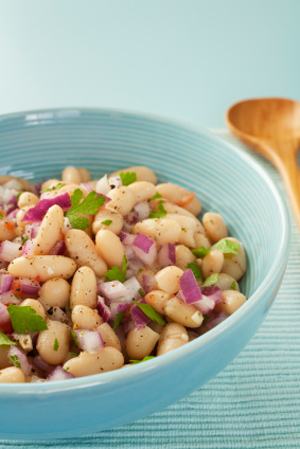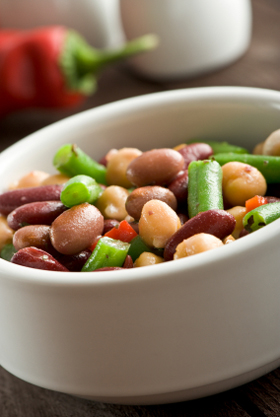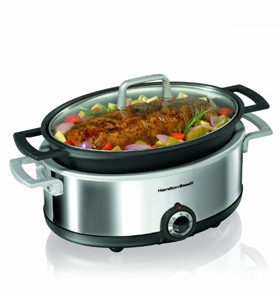 |
 |
Any bean can be the base of a delicious bean salad. Here, cannellini beans are mixed with red onion, cilantro and paprika in a vinaigrette. You could also add corn, potatoes, green beans, halved cherry tomatoes—whatever inspires you. Photo by Travelling Light | IST.
|
| WHAT IT IS: Heirloom beans: Dried beans far superior in flavor and taste, and far more beautiful to look at, than dried supermarket beans (and don’t even mention canned beans). |
| WHY IT’S DIFFERENT: Great texture and superior flavor. Many varieties are beautiful in their markings. |
WHY WE LOVE IT: They’re delicious and healthy, packed with fiber, vitamins and minerals, and a change of pace from rice, quinoa and other grains. |
| WHERE TO BUY IT: At specialty food stores nationwide, and online at ZursunBeans.com. |
|
|
 |
 Page 2: How To Cook Dried Beans Page 2: How To Cook Dried Beans
Overview
Before man could eat beans, he had to invent the clay vessel. Meat and some vegetables could be roasted over the fire, but beans needed to be boiled in water.
Pottery was invented near the beginning of the Neolithic era, as hunter-gatherers settled into farming communities—from 8000 B.C.E. to 6000 B.C.E., depending on the part of the world. They taught themselves to make vessels from clay, which would have been too heavy to carry from place to place in the old nomadic lifestyle.
Broad beans are one of the oldest cultivated plants, gathered in their wild state and then bred for improvements.
Heirloom beans are those that have not been altered by genetic science or modern technology, but grown from seeds that have been handed down from generation to generation.
There are more than 10,000 known varieties of heirloom beans—4,000 in the United States alone. Your decision to discover (and enjoy!) heirloom beans means that farmers will be able to continue to grow and preserve them for your lifetime and for future generations.
How can you take part of this enjoyment-and-preservation cycle?
Cook more dried heirloom beans!
Some people think it “isn’t work the effort”; but the effort is very minor.
Some people avoid beans because of gassiness, but it’s easy to remove the indigestible complex sugars (oligosaccharides) from the outer coating of the beans. Soak the beans for an hour, drain the water, soak again and drain again. Now you’re ready to cook.
How To Cook Dried Beans
First, prepare the beans. It’s simple.
- Rinse the beans in a colander under cold running water.
- Sort through the beans and pick out any broken ones, plus extraneous matter such as the occasional pebble.
- Place the beans in a bowl or pot to soak: 2-3 cups of cold water per one cup of beans.
- When the beans grow larger in size and can be chewed, drain the beans from the water and add them to a pot. It can take two hours or overnight for the beans to plump up (depending on how fresh they are, and how much moisture they’ve retained). You’re ready to cook!
- Rinse and drain the beans again. Why? For one thing, it removes the natural properties that cause bloating in some people.
Beans vary in their hardness. Not all beans need to be soaked.
- Softer types of legumes like butterbeans, lentils and split peas can be quickly pressure cooked without soaking.
- The hardest beans, such as the soybeans, need a full 12 hours to rehydrate.
Continue below with three ways to cook dried beans: stovetop, pressure cooker and slow cooker. |
INDEX OF REVIEW
This is Page 2 of a three-page review. Click on the black links to visit related pages:
|
MORE TO DISCOVER
|
Stovetop Cooking
After soaking (see above):
- Place the rinsed beans in a pot with a lid, adding 3 cups of water per cup of dried beans.
- Bring the water to a gentle boil and cook the beans until they’re tender. Remove them from the heat when they are slightly al dente, because they will continue to cook internally for the next five minutes. No one wants mushy beans (unless it’s for bean dip).
- Drain the beans; they’re ready to eat or to be incorporated into a recipe.
Pressure Cooker
Forget soaking: In just 15 minutes, your dried beans can emerge ready-to-eat from the pressure cooker.
The pressure cooker is one of our most valued kitchen appliances. One of the easiest and most energy-saving ways to cook, it cuts normal cooking times to a fraction: For example, just 40 minutes instead of four hours for braised short ribs.
If you have a pressure cooker, you already have the instructions, which are simple:
|
|

Most heirloom beans lose their beautiful markings when cooked, but still taste delish. In this three-bean salad, pinto beans, kidney beans and garbanzos are tossed with green beans and red bell pepper in garlic herb butter. Photo by E.Z. Buyforu | IST. |
- Rinse and clean the beans to clean and to remove the oligosaccharides. Presoaking is not necessary.
- Use 1 cup beans and 4 cups water, broth or stock (rule of thumb: cover with two to three inches of liquid). If you are doubling the recipe, be sure not to fill the pressure cooker more than two-thirds full.
- A tablespoon of oil keeps the skins from popping off.
- Place and lock the lid. Bring up to pressure over a medium-high heat; then lower the heat to maintain constant pressure for 15 to 30 minutes, depending on the type of bean and your manufacturer’s instructions.
- If the manufacturer’s instructions don’t detail the cooking time for different types of beans, use this handy chart (you’ll need to scroll to the middle of the page).
Slow Cooker (Crock Pot)
With a slow cooker, you can cook one or more pounds of dry beans at once. It’s a great solution for party dishes, as well as putting nutritious food in the freezer.
A slow cooker does not require overnight soaking to plump up the beans; but soaking, draining and rinsing is beneficial for digestive purposes.
- Add 16 ounces (1 pound) of dried beans (more, if desired), two teaspoons salt per pound of beans, and enough water to cover by two inches. Do not fill the slow cooker more than two-thirds full.
- Cover and set the slow cooker for 8 hours, which will keep the beans at a low simmer.
- At 4 hours, add another teaspoon of salt, stir the beans, and taste the beans for doneness.
- Continue checking every half hour or so, and stop cooking when the beans have reached your desired doneness. Depending on the hardness of
the bean:
|
|

Use a slow cooker to make large quantities of beans (we prefer a pressure cooker for smaller quantities). The 5.5-quart slow cooker above is from Hamilton Beach. |
| |
- In 5 hours the beans will be al dente and ready to add to soups, stews and chilis.
- In 6 hours the beans will be ready to eat in sides and salads.
- In 7 hours the beans will be soft to mash and use in dips.
|
Continue To Page 3: Bean Nutrition
Go To The Article Index Above
Do you have friends who would enjoy THE NIBBLE?
Click here to send them an invitation to sign up for their own copy. |
© Copyright 2004-2026 Lifestyle Direct, Inc. All rights
reserved. All information contained herein is subject to change at any time
without notice. All details must be directly confirmed with manufacturers, service
establishments and other third parties. The material in this e-zine may not
be reproduced, distributed, transmitted, cached, or otherwise used, except with
the prior written permission of Lifestyle Direct, Inc.
|
|

|
 |